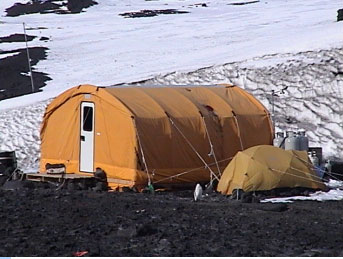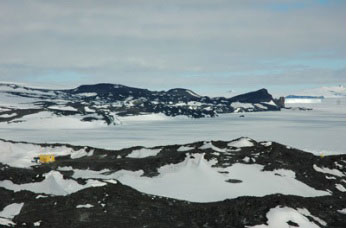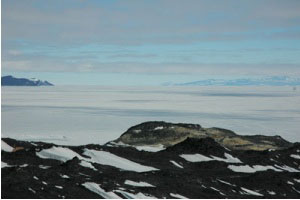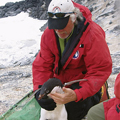Setting up Royds Penguin Camp

Two of us, Jean Pennycook (a science teacher) and I, arrived at Cape Royds, landing by helicopter chock full of food boxes, camping gear, and scientific equipment. Back in the cargo portion of the helo, there was just enough space for the two of us to sit. After off-loading, the helo flew away, leaving us to carry a myriad of boxes and stuff to the platform tent (“RacTent”) that will be our headquarters. We spent the next several hours unpacking and laying out the tent according to what we considered to be the most efficient use of the small space (10’ x 16’).

The photo above is a close-up of our camp; to the left you will see its location looking to the south with fast ice in Backdoor Bay. Cape Barne forms the other shore of the Bay.
After unpacking I went off to see how the penguins were doing in this summer of 2007-08. This season, most of McMurdo Sound is covered only by pack ice. (Editor’s note: pack ice is floating sea ice that can be pushed around by strong winds; fast ice is sea ice attached to the shoreline that stays in place even in high winds.) Thus, when the wind is blowing, as it is now, from Cape Royds toward the north for 20 km it is free of sea ice. To the south, the Sound is covered by a continuous sheet of ice — fast ice. Here at Royds at its outer sections, it is 2 meters thick; farther south it is 8 m thick. Farther south they are now landing very large cargo airplanes on the sea ice. In any case, the penguins should be happy with their easy access to the open waters at Cape Royds.

The photo at left shows the Cape Royds penguin colony (light-tan colored terrain) with fast ice stretching to the south. All the land forms in the distance are islands, the Delbridge Islands (3 km away) to the left and Black Island (20 km away) to the right. Based on counts that I made of some ‘reference’ subcolonies, there is exactly the same number of penguins here as there were on this date last year: 45 penguins (25 nests) in one group and 112 (69 nests) in the other. About 1/3 of nests had an egg, so the penguins must just now be beginning the period of peak egg-laying. Almost all the penguins in this colony should lay their eggs over a 1-12 day period, beginning a couple of days ago.










Hi David,
Met you on the ice in McMurdo this season (07-08). I worked at the power plant and was a TEA with Jean. Saw you both on CBS news. Very interesting. Say HI to Jean and hope to see you on the ice again next season. See ya Paul